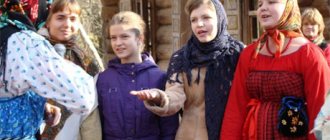Parental congratulations
After the official part of the holiday, guests are usually invited to a banquet. The mother-in-law meets the newlyweds and guests at the threshold of the restaurant with bread and salt and invites everyone to the tables.
Among the numerous congratulations, the most important role is given to the speech of the parents. The mother-in-law and father-in-law are invited first to say parting words and congratulations. Most often, such a speech is prepared in advance. This is a very touching and exciting moment, so in order not to get lost or confused, it is better to make a cheat sheet on a beautiful postcard.
Lighting up the family hearth
An important wedding tradition is the lighting of the family hearth. This is a rather ancient ritual, symbolizing the transfer of the wisdom of family life from the older generation to the younger.
The symbol of the family is fire, which the mother of the bride passes on to her daughter as the keeper of the new family hearth. To carry out the ceremony, you will need a simple candle for the mother-in-law and a large beautiful candle, symbolizing a new family hearth, for the bride. Accompanied by quiet lyrical music, the bride's mother says kind parting words and lights the newlyweds' candle with her candle (it is held by the bride), thereby symbolizing the transfer of warmth, love and experience to the new family. Usually the hearth is placed on the table of the newlyweds and taken home as a souvenir at the end of the celebration.
Removing the veil
Removing the veil is another wedding tradition that involves the mother-in-law. This ritual symbolizes the bride’s farewell to girlhood and the transition to a new role - wife, and in the future, mother. In the old days, only unmarried girls could walk with their heads uncovered or with their hair down. After getting married, they were required to cover their heads with scarves.
At the end of the holiday, guests form a circle, in the center of which the bride and her mother are invited. The presenter pronounces words about the young bride’s entry into her new role as a wife, and at this time the mother-in-law carefully removes her veil and covers her daughter’s head with a beautiful lace scarf.
Parents at the wedding.
For parents of newlyweds, a wedding is often no less important a day than for their children. Mom and dad also really want everything to go well, without troubles and incidents. However, often the older generation tries to participate in literally everything, so it is better to determine in advance the scope of their responsibilities and prepare for this wonderful day. Often, parental participation is determined by certain traditions, so matchmakers should meet in advance and discuss what is and is not customary to do in their families. Let's try to clarify the main points regarding the participation of the older generation in the preparation and holding of such an important event as a wedding.
Wedding ring
Oh, these signs for a wedding! What can and cannot be done for newlyweds with wedding rings? This question worries young people very much.
- Purchasing wedding rings is the responsibility of the groom.
- Rings must be smooth, without stones or notches, so that life is smooth, without pitfalls.
- The bride's ring should be wider than the groom's ring.
- No one should be given wedding rings to try on, either before or after the wedding.
- On your wedding day, you cannot wear any rings other than your wedding ring.
- Marriage with parents' rings is a repetition of their family relationships.
- Losing a wedding ring means separation, family breakdown.
- Dropping your wedding ring before you put it on your finger is bad luck.
Preparatory stage of the wedding
Even if you are planning a magnificent celebration, you should not place all the preparatory activities on the shoulders of your parents. In the end, they are also busy people and want to fully experience the fabulous atmosphere that will surround their children on their wedding day, and not control whether hot food is served and whether all guests have enough cutlery.
Parents can help the bride with choosing a dress, the groom with choosing a suit, and help with some stages of preparation, such as buying towels or ordering a loaf. As for the rest, it is better to entrust the preparation for the celebration to friends or special people.
Signs about clothing and jewelry
- Signs for the bride on her wedding day say that the happy chosen one must wear shoes with closed toes and heels when getting married. Then happiness will not leak out of the house. And if you also put a copper coin in the right shoe, then the life of the young people will be successful and rich. Getting married in sandals means living barefoot.
- If a woman who has been successfully married for 7 years helps the bride put on her wedding attire, then the newlywed will be healthy and successful.
- The bride should not allow her friend to stand in front of her in front of the mirror, otherwise the latter will beat off the groom. The same applies to the groom and his friends.
- In order to protect against the evil eye, newlyweds need to fasten a safety pin on their clothes, head down: for the groom - in the area where the boutonniere is attached, for the bride - on the inside hem of the dress. It is also recommended for the lucky chosen one to make a number of stitches with blue thread on the inside hem of the dress: as wedding signs say for newlyweds, this will protect the newlywed from the evil eye.
- Old shoes on the bride mean good luck in the new family. Therefore, a day or two before the celebration, it is recommended to wear shoes that will be worn at the wedding.
- Pearls worn by a bride to a wedding bring tears to her eyes.
- You should not wear jewelry to a special event - only costume jewelry - this is exactly what folk signs for a wedding say.
- What can and cannot be done for parents? The mothers of both young people should wear one-piece dresses (not suits) so that the family life of their children is free of discord.
Banqueting hall
Agree in advance with the matchmakers who will do what near the banquet hall. Mostly, the newlyweds are greeted with a loaf of bread and salt: most often, the groom’s mother holds the loaf on a towel, the groom’s father holds a tray with glasses that are filled with holy water or champagne. The bride's parents can hold icons or just stand nearby.
In some families, it is customary for the man to hold the loaf, while fathers hold glasses and bread and salt, and mothers hold icons. Also, when meeting mothers, they can shower the newlyweds with a mixture of grain, sweets and small money.
Meeting of the newlyweds with a loaf
This tradition has a thousand-year history. As a rule, the ceremony is performed by the groom's mother. After the newlyweds have signed their names, they go home, where relatives and guests are waiting for them. When the newlyweds meet, the groom’s mother presents the newlyweds with a loaf of bread placed on a decorated, painted towel. According to the superstition (which observant guests probably noticed), the one who took a bite, or in some cases broke off, a larger piece, will be the head of the family. It is customary to put salt on the top of the loaf so that the young people salt pieces of the loaf for each other, as a sign that they will “salt” each other for the last time. Afterwards, the father and mother bless the newlyweds and wish them love, happiness and prosperity.
Having greeted the newlyweds with bread and salt, the groom's parents should sprinkle them with rice and coins. After all, rice is a symbol of long life and successful birth of offspring. The process of showering rice, coins, and sometimes sweets and flower petals is also carried out near the registry office. But there anyone can do this, but at home it must be the groom’s parents. Among other things, the groom's parents organize a buffet after all these rituals. They should take care of drinks and snacks so that the newlyweds and all the guests can get some rest.
Wedding traditions. Parents at the wedding.
Sometimes the young people have their hands tied with a towel, then one of the fathers must lead them into the hall and lead them around the set table three times. If you want to stick to traditions, you can do this in the bride’s house, leading everyone around the set table.
Also, another custom is dancing with parents: the groom dances with his mother-in-law, the bride with her father-in-law, then the groom can dance with his own mother, and the bride with her own father.
And finally, the ritual of removing the veil. The bride's mother must give her daughter a burning candle, which will symbolize the family hearth. After the final dance of the newlyweds, the bride sits on a chair, and the groom’s mother replaces the veil with a lace scarf, confirming that the girl has become the mistress of the house. If the family hearth is lit, the young people stand with a candle, symbolizing the family hearth, and the parents must take two lit candles in their hands, cross their fire and together light the fire of the young family.
By the way, when cutting the cake, it is the parents who should get the first and most delicious pieces.
If the family of one of the newlyweds is incomplete, many rituals may not be performed, or the parents may be replaced by godparents, sisters, or brothers who have replaced the family.
Rituals and traditions at a wedding.
Each ritual associated with a wedding has long-standing roots. Rituals and traditions have migrated from ancient times to the modern world in a slightly modified form. But, nevertheless, they remained, and many today consider their observance to be the key to a happy family life.
Wedding traditions - meeting the newlyweds
Wedding traditions have been compiled for decades, and one of the important moments in the wedding ceremony is the ceremony of welcoming the newlyweds with a loaf of bread and blessing the couple by their parents. It is worth saying that wedding ceremonies, which included the process of parental blessing itself, were a prerequisite for a full-fledged Orthodox marriage and were held before the wedding in the church.
The meeting itself and receiving the parental blessing begins with the newlyweds passing through a kind of corridor created by the wedding guests from towels and standing in front of their parents. After bowing three times to their parents, the newlywed couple solemnly receives a blessing and a wedding loaf from them. Having received a loaf of bread from their parents, the newlyweds each break it from their side and, dipping it in salt, give each piece to their spouse to eat.
Wedding traditions give a special place to the wedding cake, since no wedding can be imagined without this decoration of the ceremony itself. It is the moment of joint cutting of the wedding cake - a huge confectionery structure of cream and sponge cake - that will remain in memory as one of the brightest and most colorful moments of the wedding.
The tradition of presenting a wedding cake to newlyweds has its roots in Ancient Rome. Despite the fact that 5 thousand years separate us from those times, this wedding ceremony has survived to this day. But it is worth saying that although people did not know or use the very concept of a cake at that time, in the ceremony itself at the wedding they used wedding bread baked in accordance with all traditions from barley or wheat.
According to the very ritual accepted in those days, the groom was obliged to break the wedding bread over the head of his chosen one and then give each guest a small piece of it, thus offering to share the joy with the groom. The crumbs themselves, which fell on the bride’s head from the broken wedding bread, were collected by the groom and shared with his chosen one. This ritual acted as a kind of symbol of the subordination of the future wife to her husband.
In Rus', such a wedding cake was a traditional loaf. It was in this regard that our ancestors approached on a grand scale and with good knowledge of the matter, since the preparation of this wedding attribute required the efforts of several people.
It was our ancestors who knew that kneading the wedding loaf was done exclusively by married women, and the process of baking in the oven itself was done by men. But the wedding loaf, decorated with viburnum branches and berries, was cut by the child himself. Then, at the wedding celebration itself, the cut loaf was served to the guests exclusively by the matchmakers themselves. Moreover, this entire procedure of treating guests to a wedding loaf was accompanied by the singing of ritual songs. They were performed by “loaf makers”. As a rule, the honor fell to the young people to be the first to touch the most finished loaf, and all this was done before the wedding in the temple.
Wedding
"Wedding Train"
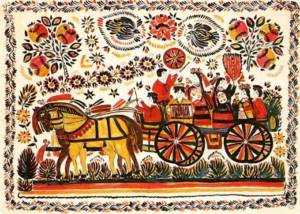
In the old days, this term meant a cortege of horses and a cart on which the bride and groom rode to church. Only the poorest segments of the population had a walking wedding procession.
The harness of the horses was decorated with flowers and ribbons, the participants in the procession sang songs and wished health and prosperity to the newlyweds. The men participating on the groom's side wore red shirts or decorated their outfits with red belts and ribbons.
"Ransom" for the bride
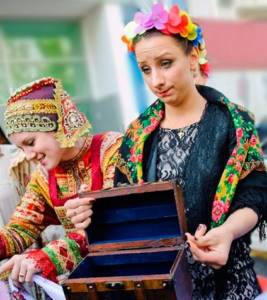
In our Orthodox tradition, all sorts of rituals associated with the “purchase” of the bride or the groom’s right of way could take place at all stages of the wedding ceremony. In some villages, they even took a nominal fee from matchmakers who just came with an offer.
In most cases, the fee was symbolic or was charged in the form of performing some action. Sometimes the ransom could not be the bride herself, but some of her belongings or part of the wedding treats. This part of the ceremony has always been the most fun and interesting. Our ancestors also loved to play tricks on the groom, for example, by offering him another girl.
Church wedding
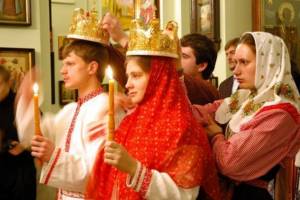
The most important sacrament in the entire wedding ritual. It was here that the bride became a wife and the groom became a husband. For the church wedding ceremony, the clergyman wore the most beautiful and formal clothes. Crowns, often in the shape of a crown, were placed on the heads of the newlyweds.
A number of ritual actions during the wedding symbolized the unity of the newlyweds. Their hands were tied with one towel or belt, they drank from the same cup or ate one piece of bread. In the north of Russia, it was customary to give young people one scarf, and they had to hold onto it and enter the church.
Only now the church wedding ceremony has acquired the same form throughout the country. In the old days, priests tried to follow the traditions of the area in which they served. They could cover the heads of the young with a cloth or “push their foreheads together.” Sometimes the young people walked around the altar and stood on one towel, scarf or belt. You will be surprised, but the tradition of closing the symbolic lock with a key after leaving the church and throwing it into the river has existed for several centuries.
Party and feast
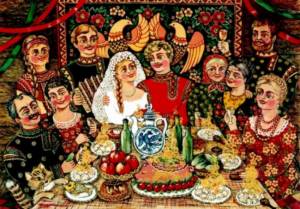
Immediately after the completion of the ceremony, festivities began in the church. They usually took place in the groom's house. Due to the abundance of red in the clothes of the newlyweds, in some regions of Russia the traditional feast is also called the “red dinner”.
There could be several wedding tables at once. Guests were divided by gender, social status or family ties. In any case, the most important detail of the ceremony was the process of seating the guests. The young people seemed to indicate their attitude towards each of the guests. Here, for the first time, the newlyweds could sit down together at the table, in the place of honor, under the icons.
Wedding ritual of covering the bride
In this rather beautiful wedding ritual, a special place and participation is given directly to the bride and mother-in-law. It was our ancestors who endowed this ritual with special magical features. In the very ritual of covering the future wife and mother, the mother-in-law herself removed the veil from the young woman and covered her head with a scarf. It was precisely such actions that embodied the sacred meaning that a girl was already becoming a woman and a wife.
At this moment, the bride herself can, as if jokingly, throw off her scarf twice, but the third time the mother-in-law ties the scarf on her daughter-in-law’s head. After this, all the unmarried girls present at the wedding lead a young round dance around, while the bride herself tries on her veil on each head, thereby wishing each of them to get married as soon as possible and find their family happiness.
Wedding
- During the wedding process, the box from the wedding rings is taken by one of the friends who wants to get married as soon as possible.
- Wedding in a hat means divorce, in a short veil means sick children, without a veil means deception and suffering.
- The wedding candle should be protected and lit to help with the first birth.
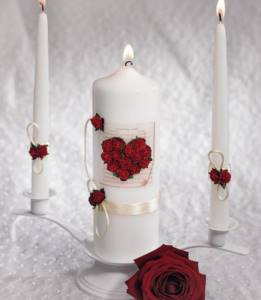
- After the wedding, the newlyweds should look in the same mirror together at the same time - this is a sign of a long and happy life.
- If it starts to rain during the wedding, the young family will be wealthy.
- If the bride drops her scarf while standing under the aisle, she will be a widow.
- Whose candle burns out first during the wedding will die first.
- If the candle suddenly goes out, the young people will face a difficult family life or an early death.
- Wedding candles need to be blown out at the same time, this will be the key to a long and happy life.
Wedding ceremony of handing over the family hearth to the newlyweds
The whole essence of this ritual is that it is the parents of the young who symbolically transfer the warmth from their family hearth to the new family. The ritual itself is carried out at the end of the wedding festivities, when the newlyweds themselves go to the new home and the parents, both from the groom and from the bride, light a candle and at the same time light the common candle of the newlyweds with two candles, while pronouncing wishes and instructions for the young family.
The ritual itself also provides for the direct participation of wedding guests. They form a circle and also hold candles in their hands, thereby forming a kind of protective circle around the young ones. The lights in the hall are turned off and the newlyweds stand in an improvised protective circle with one common wax candle. At this time, each of the guests says a short wish and then raises the candle up and mentally repeats the wish spoken out loud and lowers the candle.
After all the guests have expressed their wishes, the parents of the newlyweds approach the couple and pronounce their instructions and light the common candle of the new married couple with a flame from their candles. Having lit a candle and wished the couple all the best, the candles are not extinguished but placed on the tables, thereby creating a romantic atmosphere during the wedding ceremony.
Wedding customs and traditions in Russia
Blessing of the Young
The obligatory tradition preceding the sacrament of marriage was the blessing of the parents, which was strictly observed. The children turned to their relatives with the words: “Bless, father, mother!” In response, mother and father, holding the icon in their hands, answered: “God bless!” In ancient times, almost all people were baptized. At the present time, unbaptized young people who receive a blessing with an icon are more likely to follow fashion, since they do not receive God’s blessing as such.
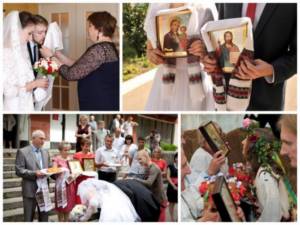
Rituals
Along with the high degree of religiosity of the Russian nation, the people sacredly believed in otherworldly forces. At the wedding, it was necessary to have a sorcerer or sorcerer present, who would protect the young people from the evil eye and distract satanic evil from them with cheerful jokes and games. At a modern wedding in Russia, the sorcerer is easily recognizable in the guise of a daring toastmaster. The ceremony organizer creates a festive atmosphere at the celebration, cheers and entertains the guests.
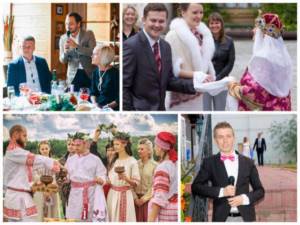
Matchmaking
According to the old Russian covenants, the hassle of matchmaking fell entirely on the parents. They had the final say on whether there would be a wedding or not. It was the parents who determined the size of the dowry and controlled the expenses of the celebration. Wedding traditions in Russia today allow children to make their own choices, as well as resolve issues related to organizing the celebration. But as before, a visit to the bride’s parents for official permission to marry is considered a sign of decency and respect.
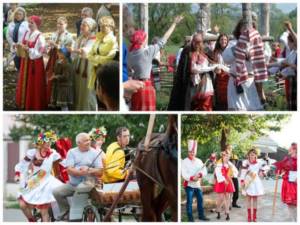
Ransom
In Russian wedding traditions, it was natural for the groom and his parents to pay for their happiness, that is, to make a ransom. Today, the ransom ritual is a fun activity for young people, friends and all participants in the celebration. The impatient newlyweds are given tasks by their merry guests and come up with obstacles on the way to their beloved. Usually the groom pays off with small sums of money or sweets.
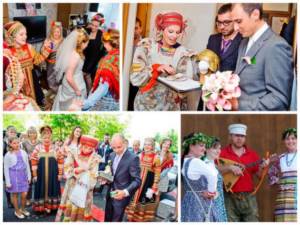
Collusion
In Rus', after matchmaking, there was a custom of collusion. This was the name given to long conversations about joint investments in the wedding budget. The size of the bride's dowry, family capital and ransom were discussed. Such an event is reminiscent of the legal registration of a marriage contract, which regulates the expenses of family members and inheritance in the event of divorce.
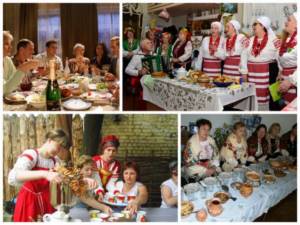
Feast
In Rus', young people were given a wedding loaf with a salt shaker before a gala dinner. After tasting the ritual bread, the newlyweds bowed at the waist to the guests, and they, in turn, symbolically blessed them, showering them with grain, a symbol of wealth and prosperity. Now, when leaving the Wedding Palace, the bride and groom are given a fireworks display of beautiful rose petals. And during the holiday, a ritual loaf is eaten.
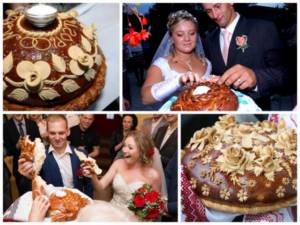
The custom of shouting “Bitter!” Previously it happened a little differently. The bride approached each guest in turn with a festive shot glass on a tray. After drinking, the invitee shouted “Bitter!”, thus demonstrating that he was given an intoxicating festive drink. In return, it was customary to place sums of money and gifts on the tray.
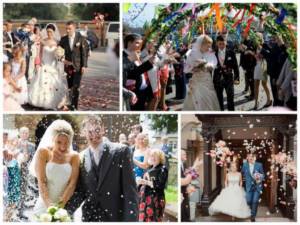
Modern Russian wedding traditions associated with the feast have acquired new interesting aspects that are already firmly rooted among the population. Thus, witnesses hold together two bottles of champagne for a young family. Newlyweds save the first bottle of sparkling drink until their first wedding anniversary, the second is supposed to be opened in honor of the birth of their first child.

According to wedding customs, the dance evening is opened by the newlyweds with their first dance. Then everyone comes out to dance, and then, as a rule, the entertainment part of the celebration begins.
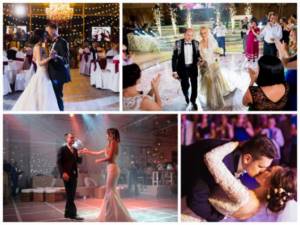
Wedding
The wedding ceremony is currently not always carried out or is postponed to another time. After registration and visiting the church, the newlyweds take a pleasure walk around the city. During such a trip, innovative rituals of modern weddings often take place. For example, on bridges, two people close the lock together, which symbolizes the inviolability of marriage. Or they tie pink and blue ribbons to the pigeons' paws and release them to determine the sex of the child. Whichever ribbon the dove flies higher with will mark the gender of the unborn baby.
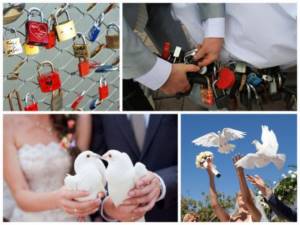
Bachelorette and bachelor parties
Girls' get-togethers before marriage are a long-standing wedding tradition in Russia. The bridesmaids went to the bathhouse, carefully washed the bride's braid, and shared stories about unhappy marriages in order to ward off the evil eye. It was not customary to hold a bachelor party in Rus'; the young guy simply got himself in order: he washed himself in the bathhouse and got his hair cut.
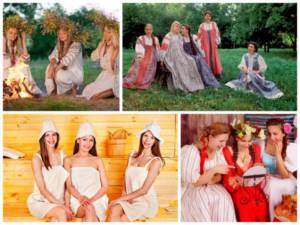
Wedding rings
Stringing gold and silver rings on each other's fingers is a worldwide tradition. The ancestors of this event are considered to be the ancient Egyptians, who were the first to introduce a beautiful and romantic custom. Today, not a single wedding in the world is complete without the exchange of rings.
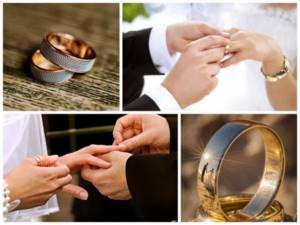
The bride's bouquet
The prototype of throwing a bouquet into a crowd of girls at a ceremony is the old ritual of passing a wreath from the bride’s head to a close friend. This ritual determines the future newlywed. At a modern wedding in Russia, a piquant nuance was added to the tradition. The bride removes the garter from her stocking and throws it to the single men to see who is the next potential groom.
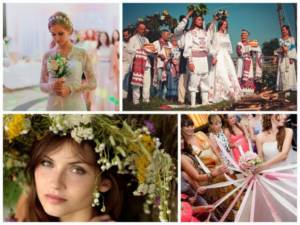
Bride kidnapping
Of course, now no one kidnaps a happy girl, unless the Russian bride’s groom is a Muslim. In Rus', a newlywed from a simple peasant family could sometimes be kidnapped by a despotic landowner. And in order to protect his beloved, the groom had to pay off generously.
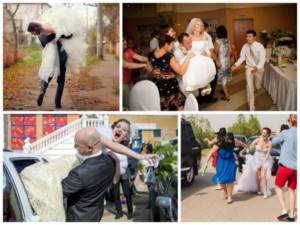
Bride's slipper
The Russian wedding tradition of the groom's friends stealing the bride's shoe on the second day for the sake of a comic payoff, took place differently in ancient times. The young newlywed herself offered to try on her bridesmaids’ wedding shoes. The girl, for whom the shoe fit, rightfully demanded a ransom from the young man.

Rushnik
A towel or towel in Rus' is a special ritual wedding item on which the wedding loaf was carried out, and in the church the newlyweds were supposed to stand during the wedding. In some settlements, newlyweds tied their hands with an embroidered holiday towel. The bride gave a beautiful ethnic towel to her betrothed for matchmaking; several types of towels should have been included in the dowry.

Wedding loaf
Bread has traditionally been considered a sign of wealth and prosperity among Russian people. Therefore, the young were supposed to taste this delicacy so that their life would be without need, hunger and deprivation. The modern interpretation of the ritual has transformed into a comic form. Biting off a loaf of bread, the bride and groom strive to grab a larger slice in order to take the leading position in the couple. In ancient times, it would never have occurred to anyone to guess about the head of the family. Rus' was ruled by a strict and sometimes cruel patriarchy.
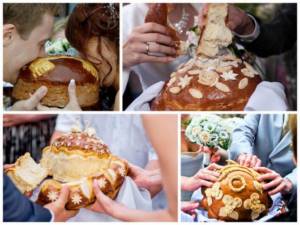
The wedding night
The pre-wedding chores are over, the feast is over, and the most mysterious and beautiful night in the life of lovers begins - the first wedding. The wedding tradition of bringing a young wife into a new home in your arms also has a magical background. In ancient times, the groom thus averted his eyes to evil spirits, pretending that he was carrying a child.
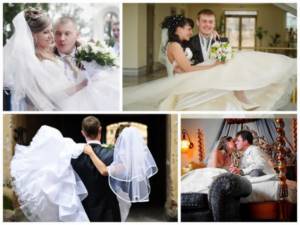
The custom of spending the first wedding night outside their native walls encourages young people to hide from evil spells and hide somewhere else. Relatives often provided the newlyweds with overnight accommodation, or as an exotic option, the young people were sent to a hayloft, an equipped barn. Modern newlyweds also crave adventure and for this they book a hotel room or rent an apartment.

Unlike Slavic traditions, the second day of the banquet became optional. Instead, young lovers prefer a honeymoon or a honeymoon in some resort location.
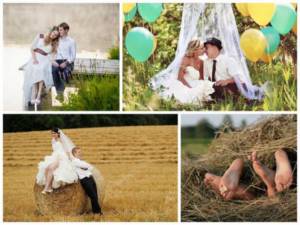
Despite the fact that culture is constantly changing and many traditions are losing their relevance, a wedding celebration will forever remain the most magnificent and memorable event in life. And for the wedding to become a real holiday of love and fun, you need to make every effort and prepare properly.
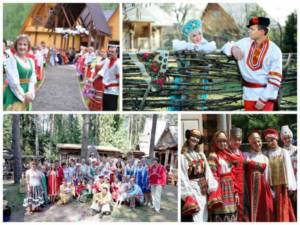
Wedding signs and rituals for a happy family life
I would like to once again dwell on certain signs and customs, the observance of which, according to the beliefs and convictions of many, can make the marriage itself strong and long. In particular, there are a lot of signs regarding the bride’s attire. First of all, we are talking about the number of buttons on the bride’s dress - it must be even, while the bride’s shoes must not contain laces or strings, and underwear must be white.
Many people believe that the number of guests at a wedding should be odd - this will ensure the newlyweds have a long and happy family life together. After the wedding in the temple, the bride had to give out change to everyone she met - this is what ensured the young family prosperity and financial well-being. But showering a couple with grain or candy also promised the couple prosperity and a sweet, prosperous life.
An equally interesting wedding sign is that many newlyweds put small coins in a glass for prosperity and success. It is these coins that should be kept in the future under the tablecloth on the table in the newlyweds’ house. This ritual was accompanied by attracting wealth and well-being to the home.
What is possible and what is not allowed on your wedding day?
- Before entering the house, the newlyweds need to break a plate for luck.
- The bride is brought into the house in the arms of her legal spouse, so that she can be carried in his arms for the rest of her life.
- Throughout the evening, parents should ensure that no one adjusts the young people’s clothes.
- The couple should dance at a wedding only together. If a dance with parents is planned, then after it the parents should reunite their children.
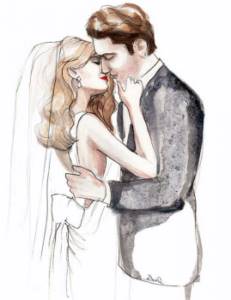
- If the bride's heel breaks, this means a “limping” family life.
- If a dress is torn at a wedding, then there will be an evil mother-in-law.




